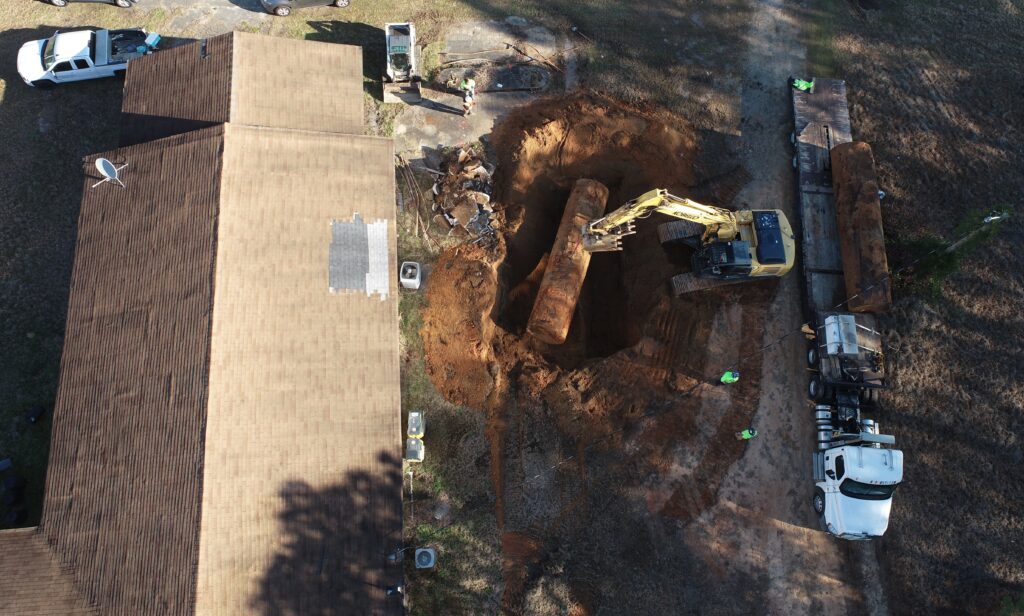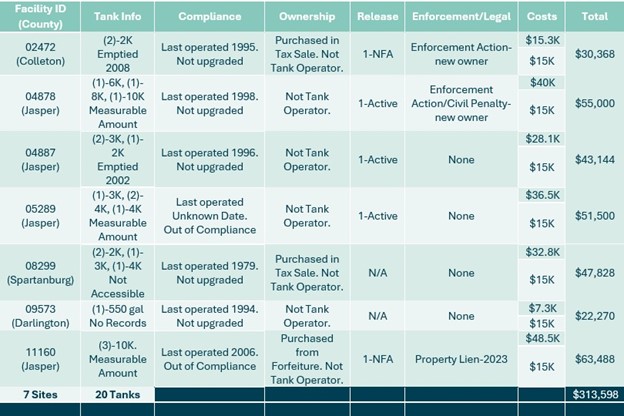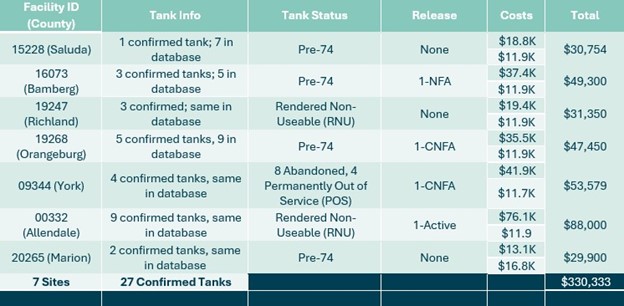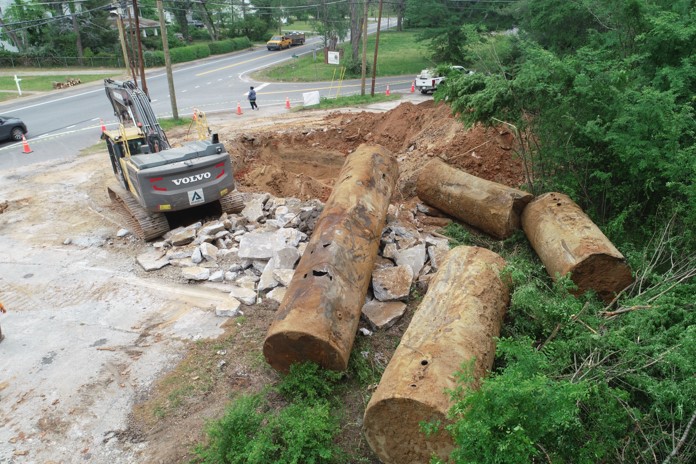Leveraging Brownfields Funding to Remove Out-of-Compliance Underground Storage Tanks in South Carolina

Project Beginnings
It is often said that you should not reinvent the wheel, meaning that someone else has likely already perfected the task. This was the case for the South Carolina Department of Environmental Services (SCDES) when it came to utilizing Brownfields grant funding to remove USTs and assess site conditions. During an EPA Region 4 meeting and again at the ASTSWMO Tanks Workshop in 2023, both the state of Mississippi and EPA Region 6 gave presentations detailing their success stories when teaming up with their Brownfields Programs. While these presentations planted a seed, an opportunity arose for the UST Division to collaborate with the Brownfields Program when SCDES was awarded a $2 million 104(k) Assessment and Redevelopment Grant through the Infrastructure Investment and Jobs Act in 2023.
This grant allowed for inventory, characterization, assessment, and clean-up plan development for brownfield sites. The Comprehensive Environmental Response, Compensation, and Liability Act (CERCLA) defines a brownfield as: “…real property, the expansion, redevelopment, or reuse of which may be complicated by the presence or potential presence of a hazardous substance, pollutant, or contaminant.” Sites contaminated by petroleum or petroleum product are also eligible if they meet the following criteria: no viable responsible party, site not assessed/investigated/cleaned up by a liable party, and site not subject to a corrective action order under the Resource Conservation and Recovery Act (RCRA). Using the CERCLA definition and criteria outlined above, the SCDES UST Division and Brownfields Program set out on a collaborative effort to remove out of compliance USTs in pursuit of site assessment.
Site Selection
The SCDES UST Division keeps a list of out of compliance underground storage tanks that do not have a viable owner, were not upgraded to 1998 standards, and through extensive enforcement and legal proceedings have accrued fees and property liens. Internally, this list is referred to as the “Dead List.” It was the intention of the Division to start with these sites. Based on the requirements for petroleum sites to meet the criteria mentioned above, 29 sites were selected to evaluate further.
Initial steps involved contacting property owners through mail and by phone to gain access to the sites themselves. While many property owners were not willing to grant access, permission was acquired for seven sites. UST staff conducted site visits to verify the tank information stored in the database, gauge tank levels if accessible, observe site conditions, and meet with property owners. Once this was complete, the UST Division and Brownfields Program met to discuss bid specifications and devise a detailed work plan. Each site was discussed with the Brownfields Program to ensure that nothing was overlooked during the initial steps and that all sites met the criteria required for funding.
Contract Development
The general framework for the bid solicitation was modeled after a previous UST Division tank removal project. Alterations were made to add assessment language and meet the requirements of the 104(k) Assessment and Redevelopment Grant.


The contract was divided into two parts, with the work completed on each of the seven sites including tank removal (emptying, removing, and disposing) and a modified Tier I site assessment plan (eight grab samples analyzed for BTEX, polycyclic aromatic hydrocarbons, oxygenates, ethylene dibromide, and metals; three permanent monitoring wells; and lithologic description). Estimates were provided based on database records and field observations for the total number and contents of the tanks, as well as quantity of the contents. Twenty tanks were registered in total across the seven sites. The first contract ran from March 13, 2024 through May 24, 2024 and was awarded for $313,598. An extension to July 31, 2024 was granted. Table 1 shows an overview of each site and the associated tanks, as well as the total cost (the costs column breaks out the tank removal costs and assessment costs respectively in Table 1).
With the success of the first contract, a second evaluation was completed to identify any additional sites from the original list where property owners may now grant access. The same process was used to narrow down the sites as well as a similar bid structure. Again, seven sites were identified totaling 39 potential tanks and 27 confirmed. Unlike the first set of sites, some of the sites in the second set only had tank estimates due to incomplete records. The contract period was from February 1, 2025, to May 31, 2025 and was awarded for $330,333. Table 2 shows an overview of each site and the associated tanks as well as total cost.
Results

At the conclusion of the first contract, all seven sites were assessed and a total of twenty tanks were removed. Based on an UST Division Regulatory review of the results collected during the tank closures and groundwater sample collection, three sites were recommended for continued remediation (active releases already existed at these sites), one was issued a No Further Action 11(results below Risk Based Screening Levels), and three were referred to the UST Division Assessment Section. This included two re-opened releases. The Assessment Section reviewed the data and calculated Site-Specific Target Levels (SSTLs). The results from the initial sampling were below these levels for all three sites. Therefore, they were each issued a Conditional No Further Action (results below SSTLs).
The second contract is still ongoing at the time of this writing. Six removals have been completed, and assessment is scheduled to be completed by the contract deadline of May 31, 2025. So far, 24 tanks have been removed, which is one more than anticipated.
Conclusion
Aside from gaining property access, which was the most difficult hurdle of this project, other challenges did present themselves. The lack of historic records in the database due mainly to pre-1974 tanks made the construction of the bids less accurate. Due to the location of a few of the sites in the low country of South Carolina, compaction was hindered by increased water levels causing the contractor to expend unforeseen costs. However, the response from the property owners that participated was overwhelmingly positive.
The collaborative efforts outlined in this article between the SCDES UST Division and Brownfields Program exemplifies the importance of interdepartmental communication and ingenuity. Upon the completion of the second contract this year, 14 total sites will have been assessed with more than 45 out of compliance tanks removed. Sites that have been issued a NFA (No Further Action) or CNFA (Conditional NFA) can be returned to their owners and community for redevelopment. Sites that have a new release declared may be able to apply the grant funding to their overall deductible. A total of $643,931 from the $2 million dollar award will be utilized.
Throughout the process, SCDES learned many lessons that may benefit other states looking to replicate this work. It is important to maintain good communication with the property owner, as this can allow you to gain initial site access. Consistent communication will also help the property owner understand the ins and outs of the project, stay up-to-date and build trust. Other tips include:
Responses from
Property Owners
“Thank you so much, this has been such a financial relief. Not having the money to remove the tanks has been a set-back. Now we can start having community events. Thank you for recommending this program to us and following through. We truly appreciate it.”
“It is a beautiful thing. We could not have removed the tanks without these funds. We are planning redevelopment when we can afford it.”
“I am so anxious to get started with this project. I have been so worried about the situation prior to you calling me. Now I feel like I am going to be able to breathe.”
- Having contingency plans to handle different outcomes. States should consider using ground-penetrating radar and using all available data (imagery, records, talking to the public, Sanborn Maps, etc.) to document as much information ahead of time as possible.
- Ensuring contractors are able to complete the work and keep you updated on their schedules and any problems that arise.
- Conversing with your Brownfields Program and developing a plan so everyone has a clear picture and understanding of the project.
Going forward, the state plans to target orphaned releases that need initial assessment work. The partnership between the two program areas as well as between SCDES and the people of South Carolina will last a lifetime and hopefully allow for many more successful projects.
